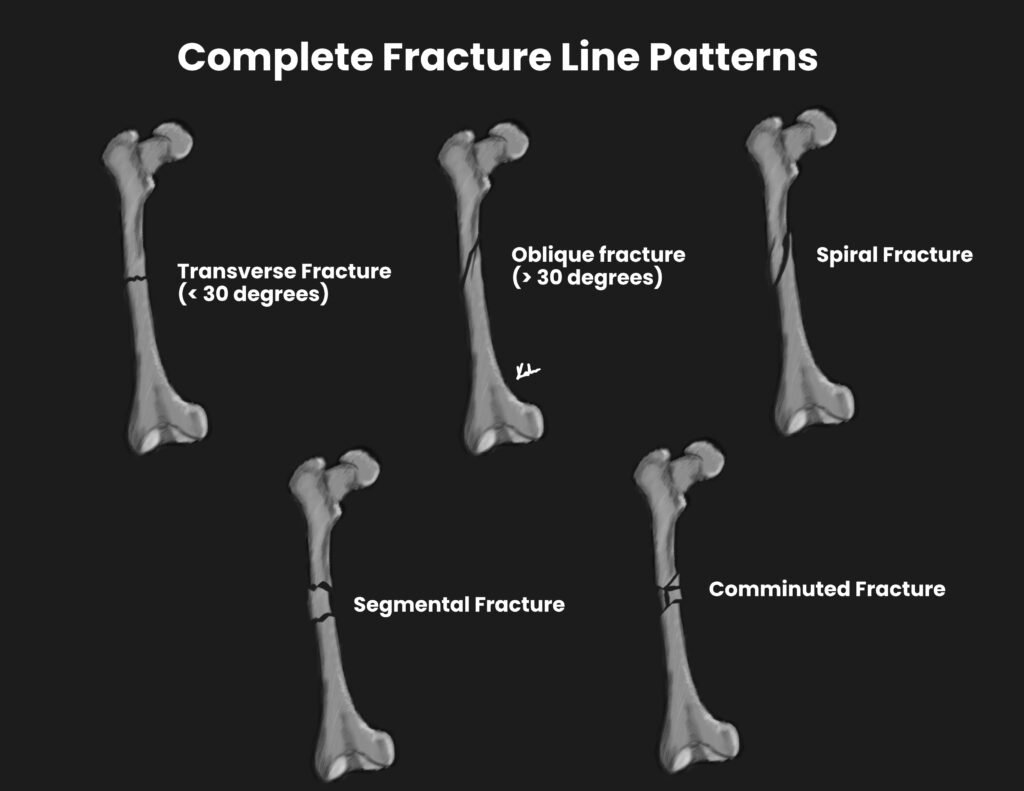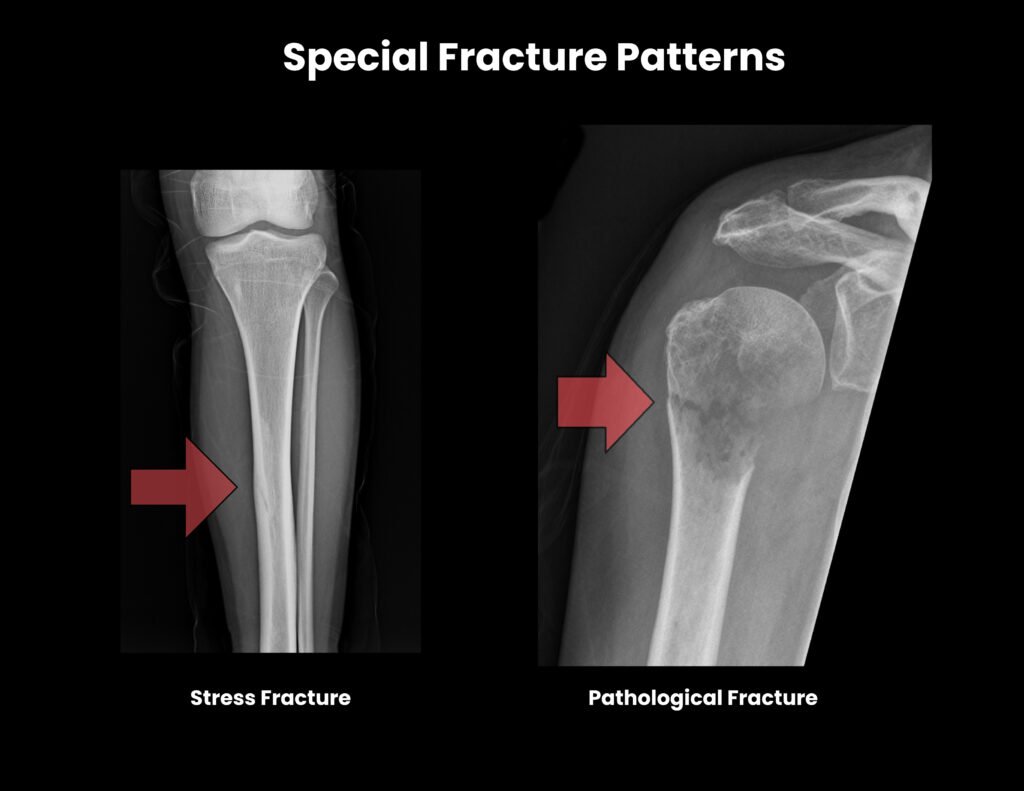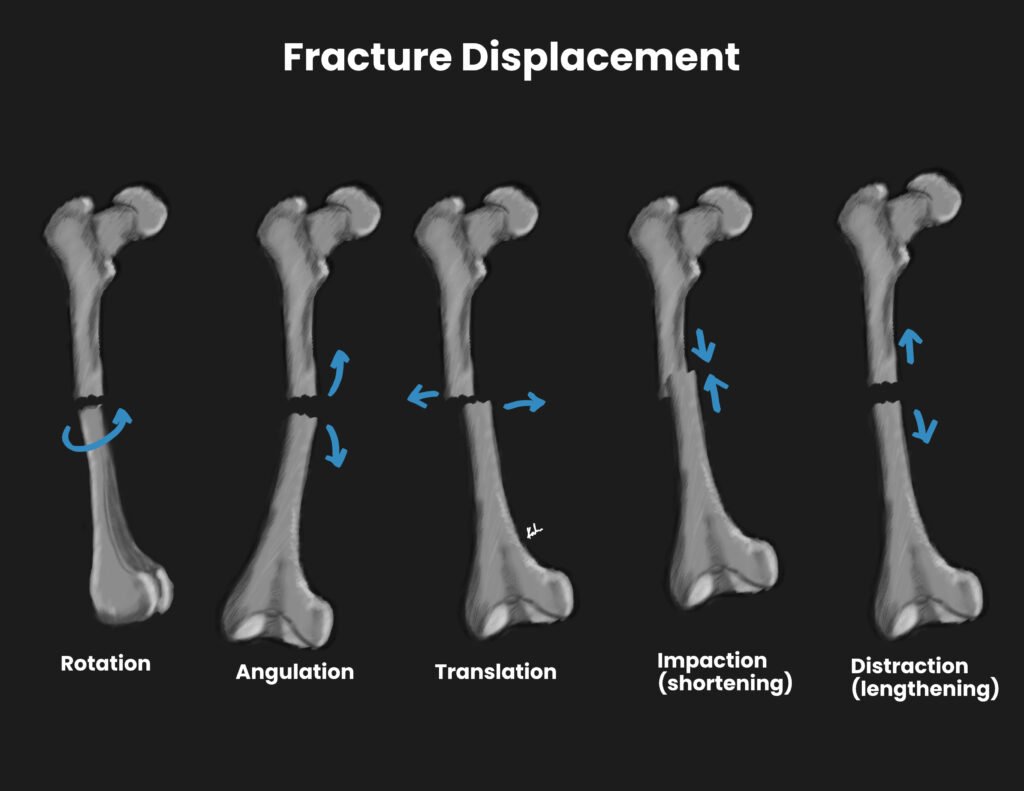Table Of Contents
How fractures occur
A fracture is a break in the structural continuity of bone. Simply put, it is a broken bone.
Types of fractures
| Type | Description |
|---|---|
| Complete fracture | Bone is completely divided into 2 or more fragments |
| Incomplete fracture | Bone is incompletely divided and the periosteum remains in continuity |
| Physeal fracture | Damage to the cartilaginous growth plate |
| Pathologic fracture | Fractures that occur with normal stresses when the bone has been weakened by a change in composition or through lytic lesions |
| Stress fracture | Fractures occurring in normal bone due to repeated loading. Repeated and prolonged exposure to stress and deformation causes resorption to occur faster than new bone formation leaving the area susceptible to fracture |
Fracture presentation
| Presentation | Description |
|---|---|
| Closed fracture | No open wound, less tissue injury, less risk of contamination |
| Open (Compound) fracture | Open wound on skin, soft-tissue injury. Higher risk of contamination |
Direct vs indirect injury
| Injury | Description | Nota bene |
|---|---|---|
| Direct injury | Bone breaks at the point of impact + surrounding soft tissue damage | Can split the bone transversely; Bend over fulcrum creating a “Butterfly” fragment. High-energy injury causes comminution and extensive soft tissue damage |
| Indirect injury | Bone breaks at a distance from where the force is applied. | May not have soft tissue injury |
Mechanism of injury
| Mechanism | Fracture |
|---|---|
| Tension force | Transverse fracture and/or avulsion at ligament or tendon insertion |
| Bending force | Fracture with triangular “butterfly” fragment |
| Compression force | Short oblique fracture |
| Twisting force | Spiral fracture |
- Types of bone
- Cortical bone
- Cancellous bone
- Growing bones
- Pathological bones
- Where are stress fractures commonly seen?
- Athletes
- Dancers
- Military personnel
- Gruelling exercise programs
- Increased exercise intensity from baseline
- Patients with chronic inflammatory diseases who are on treatment with steroids or methotrexate
Fracture Line Patterns
Spiral fractures have a pointed tip and heal rapidly. Transverse and oblique fractures take longer to heal than spiral fractures
Fracture line patterns
| Classification | Examples |
|---|---|
| Simple Fracture line | Transverse fracture (< 30 degrees), Oblique fracture (> 30 degrees), Spiral fracture |
| Complex fracture line | Segmental fracture, Comminuted fracture |
| Incomplete fractures | Greenstick fracture, Torus (Buckle) fracture |
- Fractures patterns in immature skeleton
- Complete fracture (rare, more common in mature skeleton)
- Incomplete fractures
- Greenstick fracture
- Torus fracture (Buckle pattern, common in the distal radius)
- Plastic deformation (change in the structural integrity, bone is not in its anatomical position)
- Special fracture patterns
- Growth plate injuries
- Pathological fractures
- Congenital
- Secondary to Pediatric tumors
- Fractures patterns in mature skeleton
- Complete fractures
- Simple: Transverse, Oblique, Spiral
- Complex: Segmental, Comminuted, Wedge
- Incomplete fractures
- Special fracture patterns
- Stress fracture (e.g. march fracture)
- Pathological fractures
- Complete fractures



Fracture displacement
| Displacement | Description |
|---|---|
| Translation (shift) | Fragments are displaced sideways, backwards or forward in relation to each other |
| Angulation (tilt) | Fragment is tilted or angulated in any direction. The distal fragment is used to describe angulation. |
| Rotation (twist) | Fragment is twisted around its longitudinal axis |
| Lengthening (Distraction) | Separation of fragments causing elongation |
| Shortening (Impaction) | Overlap of fragments causing shortening |


